HISTORIC 600-ACRE FAIRFAX FARM RETURNS TO WILDERNESS - Wirt-Calhoun Backwoods Has Many Tales

The late Charles McCoy of Elizabeth looks over the expansive Fairfax
Farm, now returning to the wilderness, where he spent his
early life, located in a large bend of the Little Kanawha
River, part of the original holdings of Lord Fairfax
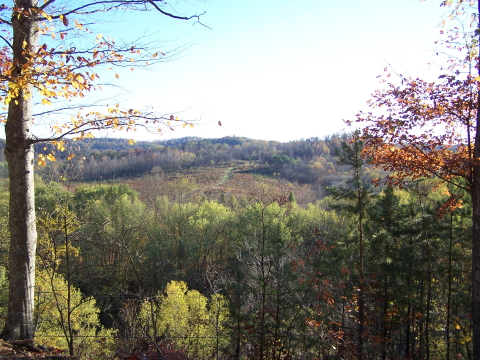
The Katy's Run, Sixteen Ridge and
Fairfax Farm area is remote and wild

Shown is the once 600-acre farm (circa 1960s) on which a
number of families lived over the last 150 years, a life
of self-sufficiency, the McCoy family the last tillers
By Bob Weaver 2012
The Fairfax Farm lies mostly in Wirt County near the edge of Calhoun, originally over 600 acres that rests in a giant bend of the Little Kanawha River, one of the largest pieces of rich flatland in the region.
Notable is the Fairfax history going back to Thomas Lord Fairfax, who once owned five million acres of Virginia and West Virginia. The Fairfax holdings led to the use of the family name on everything from counties and colleges to beer parlors and hamburger stands.
In West Virginia history, the Fairfax Stone, a surveyor's marker and stone that marks a straight line boundary between West Virginia and Maryland.
The Charles and and Hanna Ewing McCoy family had eight children, the last caretakers and sharecroppers before the land was sold to Westvaco for timber development, during the time it was owned by Dr. F. L. Blair of Parkersburg.
Dr. Blair purchased the Fairfax Farm about 1945, formerly owned by the Belts and McConneheys, building a landing strip on the property and frequently flying his plane to a get-a-way cabin on the property.
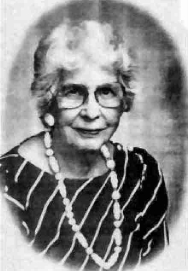 The best recorded recollections of Fairfax Farm is in an autobiography "Reclaimed Memories," by Elizabeth Thrash Brady (left) (1907-2002), who recalls moving with her family as a child from Braxton County to the farm in 1917, calling it a beautiful but isolated area.
The best recorded recollections of Fairfax Farm is in an autobiography "Reclaimed Memories," by Elizabeth Thrash Brady (left) (1907-2002), who recalls moving with her family as a child from Braxton County to the farm in 1917, calling it a beautiful but isolated area.
Elizabeth was one of 10 children of Marion James and Lillie Josephine Henderson Thrash, who farmed the fertile land and raised livestock when it was owned by Newton McConnehey of Parkersburg.
Her account of life on Fairfax Farm, and later moving to Creston, Elizabeth and Parkersburg, is a tender account of the life and times of a transient family and their struggles to provide for themselves.
RECLAIMED MEMORIES OF FAIRFAX FARM: ELIZABETH THRASH BRADY
The next move we made was from Braxton County to Wirt County. This was quite an experience for all of us. We moved to a beautiful but rather isolated area known as "The Fairfax Farm." It was said to be a part of the Lord Fairfax grant of land. It was owned and stocked by a man named Newton McConnehey who lived in Parkersburg.
My father was the manager and farmer and received a good share of the profits when cattle were sold. My brother Ted remarked once that this period was the most prosperous of our lives while we were growing up. Mr. McConnehey was such a nice gentleman. We were always happy to have him visit. He sent a big box each Christmas with a package for every member of the family.
The farm lay in a big bend of the Little Kanawha River. A straight line on the West Virginia road map indicated a move of about fifty miles from Bakers Run to the farm. No roads or rivers ran straight, so to travel between the two would probably mean a distance of seventy or seventy-five miles, over hills and through valleys, northwest of Baker's Run.
The farm had many acres of flat meadow land above the usual flood stage of the river. On the plateau, just above the sandy river banks around the curve of the river, were huge chestnut trees. They must have been planted for they were so evenly spaced.
We looked forward to the first frost and the opening of the chestnut burrs. The entire family would then gather the nuts together. I remember one year that all the school books changed and with the money we got for the chestnuts we were able to pay for all those beautiful new books. I was in seventh heaven!
It was said to be a part of the Lord Fairfax grant of land. It was owned and stocked by a man named Newton McConnehey who lived in Parkersburg. The farm lay in a big bend of the Little Kanawha River. A straight line on the West Virginia road map indicated a move of about fifty miles from Bakers Run to the farm. No roads or rivers ran straight, so to travel between the two would probably mean a distance of seventy or seventy-five miles, over hills and through valleys, northwest of Baker's Run.
When we were ready for the move from Baker's Run to the farm my dad and the two boys had a regular old fashioned western "drive." They put the poultry and everything they would need for camping into the wagon. With foodstuffs needed for themselves and the livestock, they left several days before the rest of the family. The furniture and other belongings went by train to Parkersburg, as did Mother and her six daughters. We went by passenger train but the furniture had to go by freight.
By this time I was a seasoned traveler. I had had three short trips before this experience, but it was the first time for some of my younger sisters. We got off the train in Parkersburg, West Virginia We were met at the station by Mr. McConnehey who put us into a cab headed for a big hotel.
Here I had my first culture shock when I saw paved streets and sidewalks and spent the night in a large hotel where we took care of our physical needs in a small room and it was flushed away! "This was my first experience with a bathroom. It was also my first time riding in a car.
I feel reasonably sure that Mr. McConnehey was paying all the expenses of this move. He and my parents seemed to be good friends. They always called him "Newt," but we children were never allowed to call older adults by their first names. In answering questions we knew to say, "Yes sir." 'No, sir' and "Yes, ma'am" and "No, ma'am."
Reservations had been made for us and we were escorted to our rooms by a bell hop who somehow, miraculously, caused the room to be brightly lighted! When we were ready for bed Mother and Ruby wondered how to extinguish the light. That was my first exposure to electric lights. Up until this time our sources of light at night were kerosene lamps. Ruby solved the problem, after experimenting, by reversing the action of the bell hop.
At the time of our move to the farm World War I was in progress in Europe and my parents were very concerned that the United States might get involved. I can remember our eagerness to read the weekly newspaper each time it arrived. Mother grieved when President Wilson, on April 6, 1917, declared that a state of war existed between Germany and the United States.
Gotthart was nineteen years old and registered for the draft. Before the Armistice was signed on November 11, 1918, Dad also had to register. We did not learn of the signing until two or three days later and there was great rejoicing when the news reached us.
We stayed on the farm for the next three years and profited financially, but the farm was rather isolated and the school was so inaccessible that my parents felt they must get us to a place with a better school. Not only was the school on the other side of the Little Kanawha River, the river bank across from the farm was very steep and almost impossible to climb in bad weather.
My older sister, Ruby, was unhappy here because of the lack of companionship and because there was no high school for her to attend. She was allowed to go to Ohio and stay with a sister of my mother's, Amanda and John Tenney. There she attended high school and received a teacher's certificate by passing a state teachers' examination. Ruby taught two terms while we were on the farm.
The first year she did not get back home often. When she did come she had to borrow a horse, or someone from home went for her with the horses. I remember one time when she was home it was decided that I should ride in back of her and bring our horse back. I know I was uneasy all the way home. I was afraid I would miss the road when I came to one of the forks. Probably, if I had just given the horse his head he would have taken me straight home. I had butterflies in my stomach until I reached a section of the road which was familiar.
It was the custom in rural areas in those days for music teachers, as well as school teachers, to move in with some family in the community. In return for board and room site taught some of the members of that family to play the old reed organ or a piano. There was a blind music teacher boarding where Ruby boarded and one weekend Ruby brought her to the farm.
This was the first time we children ever any had any contact with a blind person and we were given strict orders about how we were to respond to her. We all enjoyed her visit. We liked to listen to her tell about her experiences. She charged a small amount for those outside the family where she boarded to take lessons and Ruby took advantage of this.
It may have been this same weekend that I drank my first lemonade. I think this was the first year of Ruby's teaching. When she came home she brought a bag of lemons. We got our drinking water from a spring about a block or a little farther from the house. The water from the spring was always much colder than it was when it stood for a period of time in the kitchen.
We were often sent to the spring to get a fresh bucket of water even though there was water in the bucket. That water would be put into one of the large hogshead, used to catch rain water from the roof for washing. Ruby instructed one of us to go to the spring for a fresh pail of water. I think the water buckets of those days held about ten quarts and Ruby had enough lemons to make a whole bucket of lemonade. My! It was good! I have never had a drink of anything that I have enjoyed quite as much as that first lemonade.
Molasses making time was exciting for us on the farm. Almost every farmer raised sugar cane and at harvest time the farmer who owned the machinery to grind and extract the juices from the cane traveled from farm to farm with his equipment and when he left each family had gallons and gallons of molasses. I loved it for breakfast when we mixed it with fresh butter and ate it with Mother's good hot buttermilk biscuits. Oh, what a hardship it was during the First World War when we could not get flour for biscuits and had to eat cornbread for breakfast. That was fine for the evening meal with about a pint of milk, but not for breakfast!
I know that Ted, as well as Ruby, was not very happy on the farm. The two boys who had died in infancy and childhood would have been company for him had they lived. Wilbur was between him and Ruby and Percy was just younger. He was too voting to socialize with Gotthart and Ruby's friends, and too old to enjoy playing with his five younger sisters.
Gotthart, the firstborn of the family and ten years older than I, felt that he needed to "strike out for himself." He went to Sedalia, Ohio, and worked for our aunt and her husband, Amanda and John Tenney, on their big farm. We thought of this family as our "rich relations," on Mother's side of the family. They owned many acres of flat farm land and sold hundreds of hogs each year. Ruby had spent one school year with the Tenney family when she went to high school.
Gotthart was gone a part of the last year we were on the farm. Later, when we moved to Creston, he returned and got work there either on one of the river boats or driving a truck. He married a Creston girl, nine years his junior, Edna Merrill, in November of 1922. She had been my closest girl friend while we lived in Creston.
Our parents brought us a nice croquet set while at the Fairfax Farm and Dad and the boys spent quite a bit of time leveling and preparing the ground. I do not remember that Dad and Gotthart ever played with us, but Mother sometimes did. One of the younger children could not say my big name and she called me "Idly." So, Idly became Ted's name for me when he wanted to tease me. One day the teasing got under my skin. He had climbed up on the gate posts and yelled to me, "Hey, Idly, look!" Then he made his arms flap like a rooster's wings and imitated a rooster crowing. I picked up a croquet ball and, never dreaming that I would hit him, threw it and struck him in the back.
I know it hurt and he came after me. I yelled for Mother and was glad when she came and gave us both a little switching. I knew that was not nearly as bad as Ted would have given me if he had reached me before she did, but I always felt close to Ted after we were grown.
I do not remember that I was lonely on the Fairfax. We five little girls were company for each other. There were lots of nice places to play. The hayloft was sweet smelling when the new hay was stored in the barn. After the corn cribs were emptied in the summer we swept them out and had two nice places for playhouses.
Carports were unknown then, but between the two cribs was a large covered space for the protection of farm machinery. Over that area and the two cribs was a spacious attic where we often played. The creek, which ran through the farm, was another source of enjoyment for us. We gloried in our courage when we were able to catch craw fish back of their pinchers, in a manner that made them unable to do damage to our hands. We started out with the little fellows and, oh what an accomplishment when we no longer were afraid to tackle the huge ones, we might find under a rock as it was turned over!
When we wanted to buy anything from the store we rode horses to Creston. We often traded farm produce for the things we could not raise. Eggs and butter were valuable trade products, so we did not always get as many eggs to eat as I would have enjoyed. It was quite a treat for us to ride behind one of the adults on the horse to Creston, which was a distance of about three miles. We had to "take turns" going. There were too many to all go at once.
Until I was twelve years old, and we moved to Creston, we had never lived close enough to a church to attend regularly. We were all excited one summer while at the farm, to attend the Sunday School which had been organized and was being held in the school building across the river.
My mother taught the smaller children and the only literature we had was small cards, with a Bible picture on one side and an explanation on the other. One Sunday the lesson text was from Math. 20:21. It told of the mother of James and John coming to Jesus and requesting that her two sons be allowed to "sit, one on his right hand and one on the left when he came into his kingdom." A small boy spoke up and said, "Wouldn't that hurt Jesus?"
Another experience I remember about this Sunday School was that Ruby would sometimes teach her five little sisters the words to one of the children's hymns and that the five of us lined up in a row in front of the building and sang. I know we learned "I'll Be A Sunbeam," and the song which begins, 'Two little Hands To Work For Jesus." I do not remember that we made gestures with the "Sunbeam" one but we did all through the other one.
When I was a child there was always a long program at the school just before Christmas and another one on the night of the last day of school. Similar programs I ere held on Children's Day and at Christmas time in the churches. Every child in :he school had a part in those programs and in the churches almost every child in the community was given some part.
These programs consisted of recitations, dialogues, skits and singing. Everything was given from memory and it seemed to me we practiced for weeks before the big event. The programs were always well attended. Before the time of radio and television almost everyone in the community looked forward to getting together for a social time and to hear the children perform. We practiced so much that by the time the big day arrived I knew by heart the entire program.
The school at Bakers Run and the one we attended at the farm were both one room affairs, with the eight grades being taught by the same teacher. Sometimes there were no pupils for some of the grades. The teachers did not always have even a high school education, so they never were adequately prepared.
At both these schools the desks were double and we were always changing seat partners. But boys and girls never sat together, except as punishment. My first "heart-throb" was Boyd Reed at the farm. It had never entered my mind to be interested in any boy until Boyd whispered to me one day to meet him after school. I was about ten years old and he was a little older. When we were dismissed we met outside and he handed me a cheap pin, which I think was a prize which came with a jar of Cloverine Salve. The rest of that year we "went steady" at school.
I do not remember the name of the teacher the first year of school at the farm, but I do remember that I liked her. She lived within walking distance of the school and one day took me home with her to spend the night. It was at her parents' home that I heard my first phonograph music. I thought it was the marvel of the ages! The music was on cylinder records about the size of a 15 ounce tin can of vegetables, if my memory is correct. The phonograph had one of those huge horn mounted on the corner of the top of the machine itself. I'm sure the teacher had only a few cylinders. I know that one of them was, "The Preacher and the Bear" which she played more than once for me. I think there were only her parents and she living in the house. I slept with her that night. I thought I had been accorded a distinct honor in being invited home with her.
Almost everyone who owned a phonograph in those days had a record of, "The Preacher and the Bear" Demeaning stereotypes of black people were common in songs and jokes, among the white race until we began, after the Supreme Court decision of 1954*, to realize how unfair and degrading these were to another race.
Ruby taught one year at the school we attended at the farm. The river froze over that year and our parents were afraid for us to cross on the ice, so we did not get to go but about half the year. Ruby boarded across the river after it began to freeze over. She was not our boss when we were not in school but we were afraid to sass or disobey her when she was "teacher."
It was quite an experience to watch the ice break up when warmer weather came. It was so thick on the river that the cracking sounded like pistol shots! Someone yelled, "the ice is going out," and everyone rushed to the river bank.
The weight of the ice from above was so great that great slabs of it would be pushed on edge to a height of several feet and crash down on the ice which was still intact, breaking it up. The noise was like continuous thunder. I only remember twice that the ice was so thick it lasted for several weeks and caused such excitement when it broke up, but there would often be a thin coating part way across the river.
Rubys closest friend while we were on the farm was Ethel Garrison, who lived about a mile above Creston. One day when Ethel was visiting she and Ruby decided to ride the horses to Creston. They had the two horses saddled and were ready to mount when someone remarked that it might rain. Ruby went into the house to get her raincoat, while Mother held the reins of her horse. The horse was standing by a farm sled, from which the girls expected to mount. When Ruby threw the coat over the saddle the horse reared and Mother was thrown across the sled and her arm was broken. A broken arm in those days meant a stay in a hospital of two weeks.
The next day Mother was taken by houseboat to Parkersburg, where her arm was set. I think they just used splints under the bandage. World War I was going on at this time and many of the doctors had been called into service, so she was in the hospital those two weeks without any attention to the arm after it was set. The night before she was to be discharged the doctor took the bandage from her arm for an examination. When he called another doctor in Mother knew that the arm was not as it should be, but they rewrapped it and sent her home.
After the stated period of time had passed the bandage was removed at home. The broken bone instead of butting together at the break were lapped and that arm was about three inches shorter than the other. A gristle around them joined the two together and almost acted as a joint between the elbow and the shoulder, where the break had occurred. My parents were able to pay the hospital bill, but after they returned home they received a $25.00 doctor bill for the setting of the arm. Mother wrote about the condition of her arm and warned them not to send another statement and they never did.
-End-
Elizabeth's life was forever changed when she married Troy Brady, who later was a minister. Her writings reflect an amazing 60 year journey with him.
The Fairfax Farm chapter and her life story can be read at bradytrilogy
Fairfax Farm, Sixteen Ridge and the Katy's Run area still holds reminders of early explorers and homesteaders, shells and remnants of old houses, rock cellars, trails and cemeteries, all reminders of those stalwart families.
Oldtimers recall the Russell Richards family that eeked a living from the land, or Emery Farrell who had the misfortune of stabbing to death "Oll" Bell in the 1920's or 30's and putting his body on the front porch and then going to bed to wait for the arrival of the high sheriff.
In the nearby Sixteen Ridge woodlands is the site of the first public school in Calhoun in 1818 - Schoolhouse Cave.
See EWINGS AND ICENOGGLES ONCE GRACED RIVER BEND AREA - Katy's Run To Sixteen Ridge
CALHOUN'S HEDGER'S GHOST - Dare You Call His Name
CALHOUN'S FAMOUS SCHOOLHOUSE CAVE - Education In 1818
EARLY CALHOUN HISTORY - Schoolhouse Cave
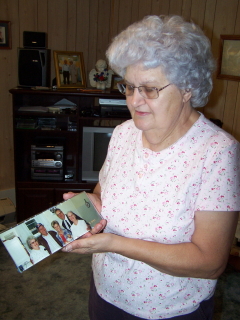
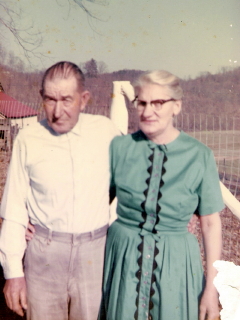
Betty McCoy Kerby (left) of Elizabeth, grew up on the Fairfax
Farm, crossing the Little Kanawha River to the one-room
Riverview School and later walking three miles to the Pine
Alley one-room school, then graduating from Calhoun High
School in 1958, "It was a life made possible by dedicated
hardworking parents," Charles and and Hanna Ewing McCoy (right)
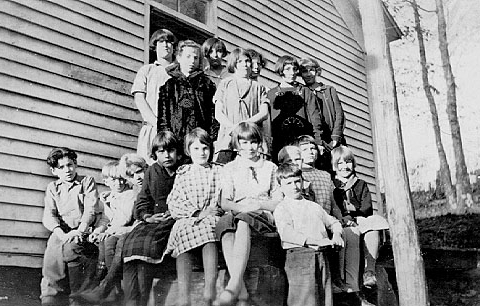
FIRST PINE ALLEY SCHOOL - The first students of the school
in the 1920s, Austin Tucker, Lloyd Vandale, Midge Vandale,
Elah Maze, Ruby Pettit, Iris Tucker, Ruth Blankenship,
Ernestine Vandale, Grace Maze, Hazel Reynolds, Ethel Rader,
Edna Basnett, Janice Pettit. Fannie Smith was teacher
(Photo Courtesy of Harold Richards)
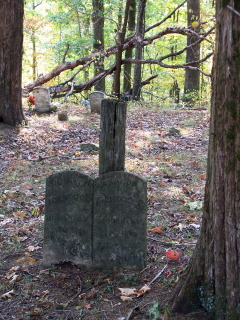
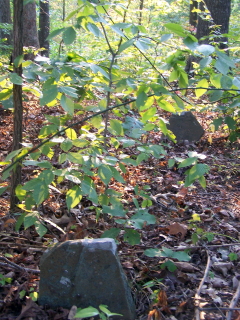
The remote area has a number of long forgotten cemeteries, with
names like Iccenoggle, Ewing, Woodring, Blankenship, Greathouse
Merrill, Boyce and Monroe, with one Sixteen Ridge cemetery
the burial site of a number of orphan children who died in a
Parkersburg epidemic and brought up the Little Kanawha by boat for burial and the grave of J. Shed, pioneer teacher (1861)
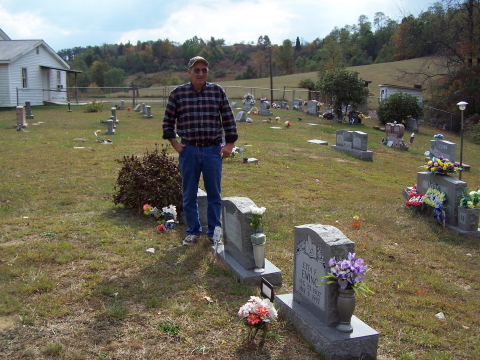
Charles McCoy in the Snyder's Chapel Cemetery,
the closest church during the 20th century